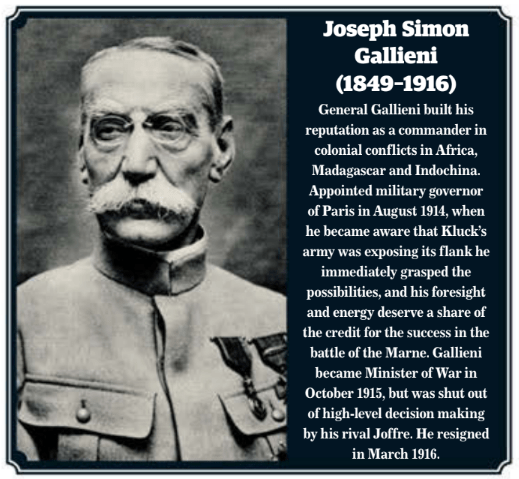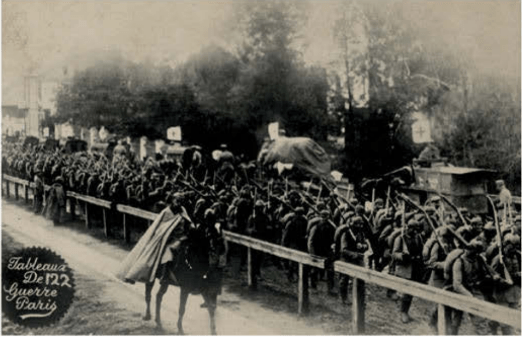Battle of Marne – SAT 29 AUG 1914 –THU 15 OCT 1914
Pushing back the German Offensive
By the end of August, Joffre had decided his force should go onto the defensive, and formed a new Army (the Sixth, under General Maunoury) to plug the gap on the left of the BEF. However, local offensives continued. Bülow had to pause his advance for two days at Guise on August 29, as the German Second Army’s flank was severely damaged by the French Fifth Army. After the battle, Lanrezac retreated and was soon replaced by Franchet d’Esperey.
Kluck, believing that Fifth Army was vulnerable and that the BEF no longer posed a threat, decide to wheel his army in front of Paris, rather than adhering to the letter of the Schlieffen plan and encircling the French capital. Allied planes saw on September 3rd that Kluck’s advance was moving in a different direction. This presented a perfect chance for the French to attack the German flank and take the strategic lead. In Lorraine, the French were on the defensive.


The army of Crown Prince Rupprecht moved closer to the 65-kilometer (40-mile) distance between the fortifications of Épinal and Toul. Contradictory orders from Moltke’s headquarters hampered Rupprecht’s advance, slowing the progress during a tough fight near Nancy. The German Crown Prince Friedrich Wilhelm’s Fifth Army forces were soundly defeated at Verdun in late August by the French Third Army, commanded by General Sarrail.
Fell Back
On 9 September, the Germans gave up and fell back to their starting positions of 17 August. In the northern sector, it did not prove easy to reverse the Allied retreat. After receiving the order to turn around, some troops, including the BEF, persisted in moving southwards Fortunately, the military governor of Paris, General Gallieni, moved up Sixth Army on 4 September, two days ahead of Joffre’s order for a general offensive. The Germans lacked adequate positioning to respond effectively to the Allied attack. Kluck, after prodding from Moltke, was slowly deploying to protect the flanks of Second and Third Armies when advanced elements of Maunoury’s forces attacked on 5 September.

The Battle of Marne
The rest of Sixth Army, plus Fifth Army and the BEF joined the battle on the following day. What became known as the First Battle of the Marne was a hard struggle. At one stage, ‘the taxis of the Marne’ reinforced the French by transporting a brigade of troops from Paris. The fight was eventually determined by the German High Command, whose strategic outlook overruled actual battlefield developments. Moltke found himself startled by the unexpected reappearance of the BEF, a force he had previously believed to be destroyed. Alongside the French Fifth Army, they marched into the thinly garrisoned space between Bülow’s and Kluck’s forces. One of Moltke’s staff officials, Colonel Hentsch, paid a visit, and it was decided that the German Second Army would withdraw if the Allies crossed the Marne.

Battle of Marne

On 9 September, the BEF did just that. Bülow fell back, with Kluck conforming to the retreat. The Germans had been stopped at the Marne. It was a great strategic victory. Some called it a miracle. The Allies pursued the Germans as they fled, and briefly, triumph appeared to be in reach. The Allied forces found the Germans manning crude trenches when they arrived at the heights above the River Aisne on September 12–13.
The Beginning of Trench Warfare
Joffre on 15 September realized that it was “no longer a question of pursuit, but of methodical attack”. The Aisne was another strategic victory, this time for the Germans. Had they been unable to hold the line there, they would have retreated some 65 km (40 miles). Trench warfare began as a by-product of the Aisne, and it would endure for another four years. After the Allies removed Moltke from his position on September 14th, Erich von Falkenhayn launched an offensive by attempting to flank the Allied left.
Joffre replied in kind, and there followed a series of attempts to turn the enemy’s fl ank as the centre of the struggle moved steadily to the north. The term “Race to the Sea” is an erroneous label; the generals were not attempting to reach the coast but rather to outflank their opponents. One such action took place at Dixmude in Belgium towards the middle of October.
Here, the defenders included French marines and Tirailleurs Sénégalais (Senegalese light infantry). Between 2 and 15 October, the BEF transferred to Flanders, and from 10 October onwards, its corps engaged in battle in locations that would later become dreadfully familiar over the next four years – La Bassée, Messines, Armentières. The fall of Antwerp on 10 October released German troops for use in Flanders. These allowed the Germans to make one more try to break through the clogging trench lines, along with several freshly formed units…

Originally posted 2023-10-16 13:00:41.




